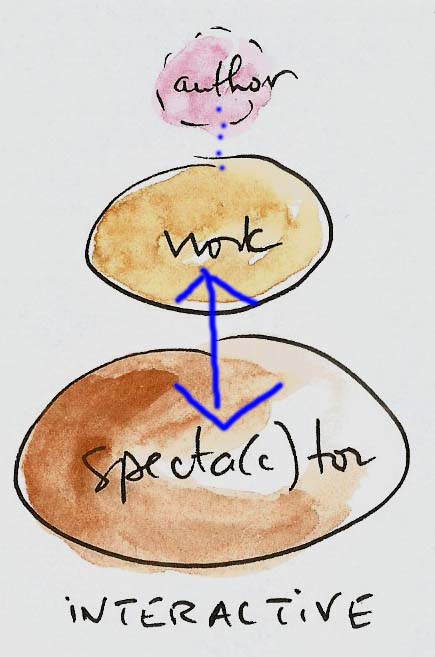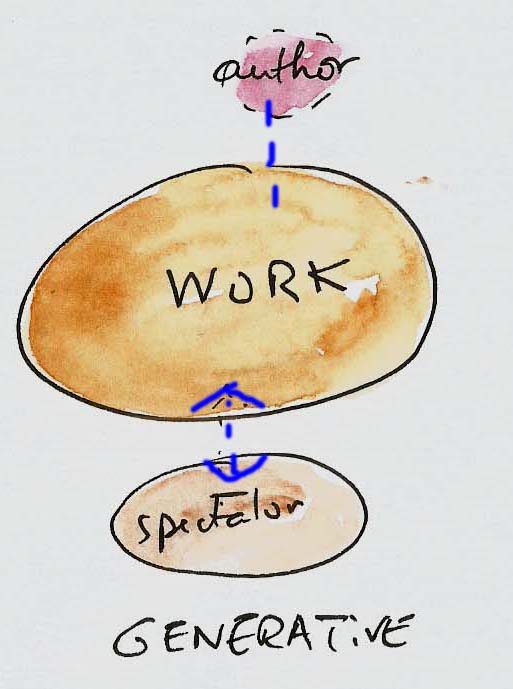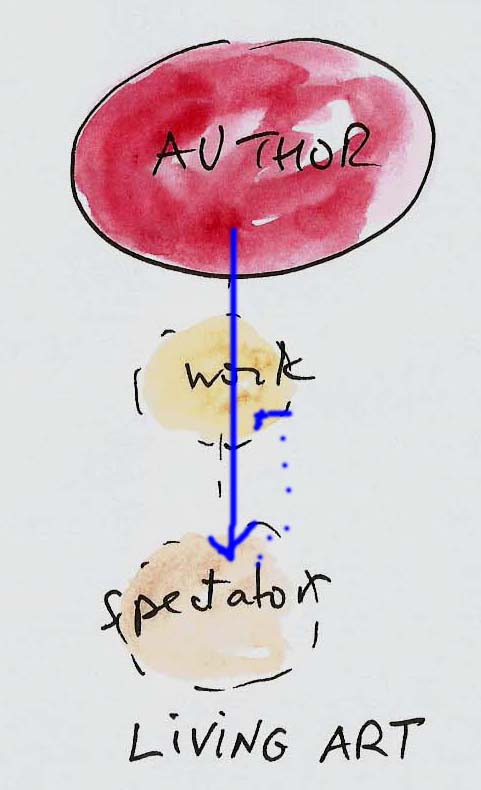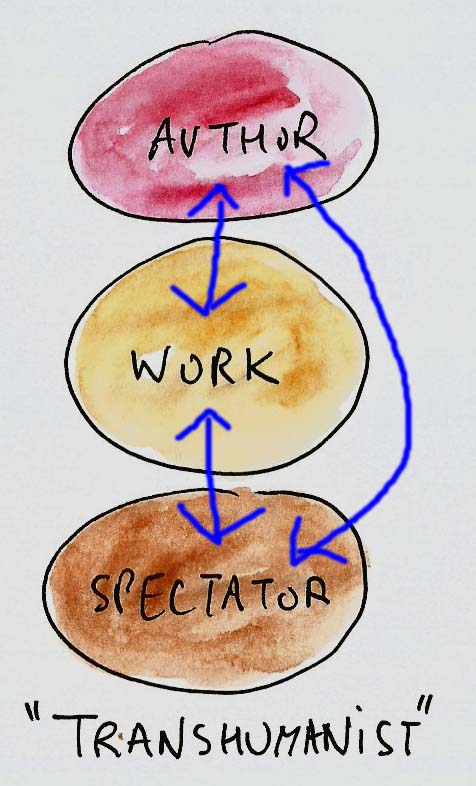Digital art: a three beings (sketch) model

Interactive model: the spectator controls, the works behaves accordingly.
Before the emergence of AI and robotics, art was a play between two autonomous beings, the author and the spectator. The work itself is now more and more autonomous. Art, then, is a three "characters" play. And the key question is: who is in control?
But, nearly at the same time, the definition of art itself has changed. In classical art, the keyword was beauty, along with the gratuity (non-funcionality) of art and art work. Of course, beauty could serve political or religious goals, but as a secondary, if not a parasitic facet. In contemporay art, the work bears the "discourse" of the artist, up to disappearing quite completely in conceptual art.
Then, facing the autonomy of their works, artists may take several attitudes
- The "don't care" way: keep using the computer as a simple tool, a facility in the hands of the artist, be it for classical beauty or for "discourse" expression. These artists, even making a intensive use of computers, dont't consider them a substantial part of their creation. That's typical of "digital art" in the American way, from the many artists liste in Wands to the Hollywood and Siggraph cinema. An extreme case was presented in 2014 with Duet, using an advanced form of virtual reality to present a deeply beautiful but artistically quite naive handmade animation.

Generative model: the work is central and controls, the spectator behaves accordingly.
- The "interactive" way: use the perceptive, behavioral and expressive aptitudes of these new beings to transfer the control to the spectators, renamed "spectactor" (this was trendy in the 1960's). If pushed to te extreme, the work becomes purely an instrument in the hands of the spectator, and perhaps we are no longer in the art domain, but in the field of games or construction kits. More balanced roles allow a sharing responsibility in the creation, as with the "UGC" (user generated contents) in games and transmedia; with a possible conflict between author (or brand owners) and a spectator, leading for instance to the distinction between "canon" contributions (conform to the intention of the creators) and "fanon" (non conform and possibly breaking the coherence of the brand development). Here, the perception tools are critical, and interactivity can make substantial progresses when new interfaces come to the general public (from the two buttons of Tennix for two to mouse, joyscick, WII, Kinect and goggles).

"Living art" model: the author controls, the work and the spectator behave accordingly.
- The "generative" way aim to create works as autonomous as possible, consider this autonomy as a major form of beauty; and expect from AI and robotic advances to afford progress on a more or less transhumanist way; in this case, if there is a "discourse", it is mainly a demonstration of the AI powers; it was clearly in my intentions when I created Roxame, and we have presented this way at long in our book L'art génératif (with Alain Lioret); the "don't care" applies here to the spectator; here, the work's behavior is central. But there is no limit to more and more advanced perception and expression aptitudes.
Here the artists consider themselves as the parents of the work more than their exclusive author. And, as good parents, they enjoy to see their children engage in more and more independent interactions with spectators and why not with the children of other authors. This vision fits with (but does not demande) a transhumanist view of history, where the present state of art and humanity is a step towards a word where machines and humans play peer-to-peer (unless the machines become radically dominant). And finally we reach a peer-to-peer situation. The symmetry of all interactions (author included) are made possible by the Cloud.

"Transhumanist" model: author, work and spectator co-control and behave together.
In Aziosmanoff discourse as in the Couchot's preface to his recent book (see our post ) and frequently in the art milieu, these terms are exclusive. If the work is interactive, the user has total control, and neither the work nor the author take part in the game. If the work is autonomous, it escapes totally to the author's as well as the spectator's control. We think that the two ways could converge in a win-win dialectics, if the computer hardware and software resources are powerful enough to operate in real time as well high level perceptions and high definition rendering (or body moves for robots), with the contribution of an important memory for learning and building a kind of "culture".
But, singularity coming or not, the machines actually available today are far from the human rational, emotional and cultural level. Moreover, independent artists don't have access to powerful AI such as the IBM's Watson machine. Then generative as well as interactive art can have somehow reached, in the middle 2010's, a limit which will be very difficult to outreach.
P.B.
Note: We have earlier proposed a four-part model ( matter, spirit, public and author) in our What Matters in Digital Art ? The (Digital) Soul! communication ąt Laval Virtual 2011.